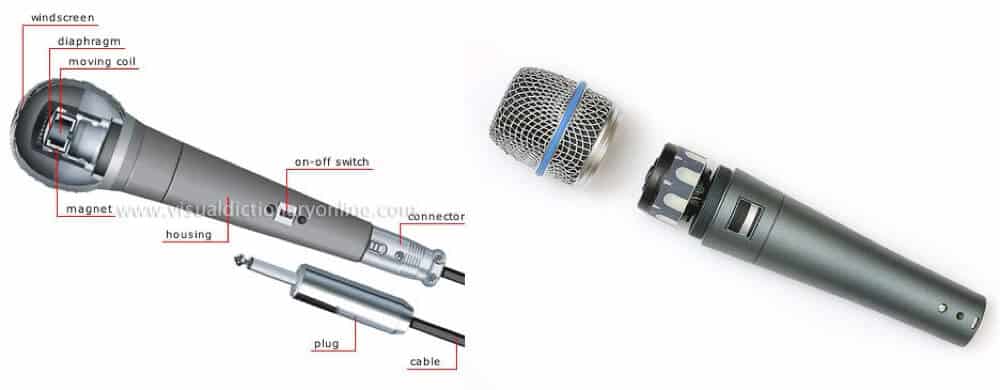
BecomeSingers is reader-supported. When you buy through links on our site, we may earn an affiliate commission. Learn More
A question I get asked a lot by newbie home studio owners is about whether dynamic microphones need phantom power. They are wary that their dynamic microphones might get damaged if their mixing desks do not have a switchable phantom power for each mic channel. Of course, they have a good reason to be anxious about their dynamic mics; after all, mics are not inexpensive.
But what is a dynamic microphone? The word dynamic may have a range of meanings. But when referring to mics, this word implies a dynamism going on inside these mics. The mic is converting sound into electrical signals via electromagnetism. Dynamic mics fall under two types—ribbon microphones and moving coil microphones.
Table of Contents
Facts About Dynamic Microphones

Dynamic microphones feature a relatively simple design. They are also rugged and economical while providing excellent sound quality and good performance. They can also handle a high level of sounds, and they seldom get overloaded. They are also not susceptible to extreme humidity and temperature.
Moving coil mics are often used on stage because they do not need external power and are sturdy. Moreover, since the moving coil dynamic microphones are the commonest mics, they are often referred to as dynamic mics. Yet, when it comes to studio use, most sound engineers would prefer, in some cases, ribbon microphones and condenser microphones.
Check this article on is my turnable mm or mc by BecomeSingers.
Understanding Phantom Power
Phantom power is a means of providing your mic with the necessary DC voltage (48V) so that the mic can function. In essence, phantom power simultaneously provides the correct amount of audio and voltage over a cable. This necessary voltage and audio are achieved via the balanced three-pin XLR cables of the microphone. The phantom power sources are usually built into the mic’s pre-processors, mixing desks, and audio interfaces.
The phantom power is a positive voltage ranging from 12 volts to 48 volts DC and usually flows through pins two and three of the XLR cable. Since its power source is invisible and runs via the same cord through which the audio signal flows, it is referred to as phantom power. You will often find a P48 switch in most audio interfaces, which turns on and off the phantom power.
Can Dynamic Mics Handle Phantom Power without Being Damaged?
As mentioned above, phantom power, as DC voltage, powers the condenser mic’s preamplifier. The microphone mixer typically supplies this phantom power. It may also come from a separate power supply. Phantom power needs a balanced circuit, wherein the Pins 2 and 3 of the XLR cable would carry 48 volts relative to that of Pin 1. Phantom voltage, of course, will not affect a balanced dynamic microphone. Yet, it will damage an unbalanced dynamic mic, making this mic to work improperly.
If you have a live sound setup, for example, you will most likely not see any difference in the functionality of your dynamic microphone when the phantom power switch is on. Yet, you will notice an extra hum in your recording due to the phantom power effect.
The way the power flows via the XLR cable’s pins would usually not result in damage to your dynamic mic even if the phantom power is switched on. Yet, if there is an imbalance in the flow of phantom power voltage applied to each pin, chances are, the phantom power will damage or even destroy the dynamic mic. This damage also happens with dynamic ribbon mics when there is an imbalance. The phantom power can destroy the mic’s ribbon.
Of course, most dynamic microphones can function well without power, although the dynamic ribbon mics would need power. Moreover, active dynamic mics also need a power supply.
On the other hand, the condenser microphone requires a certain kind of power supply. Its impedance converter needs this power supply. The non-electret condenser mic also needs it for charging its electrodes.
Is There Any Difference Between Phantom Power and Bias Voltage?
If you are just starting in the microphone business, you may get confused with bias voltage and phantom power. Many professional audio equipment users also have this belief that bias voltage and phantom power are the same. Well, this is not true, for you can never interchange the two.
I have mentioned earlier that the phantom power, as a DC voltage, powers the condenser mic’s preamplifier. The mixer or a separate phantom power supplier may supply this phantom power. The phantom power also requires a balanced circuit.
On the other hand, the bias voltage does not need a circuit that is balanced. Moreover, the bias voltage conveys power to the base of a transistor, and in this case, the transistor is called Junction Field Effect, and is hooked to the condenser (electret) mic element’s output. It functions like a converter (impedance). The impedance converter is needed by microphones that come with any condenser element.
The condenser element comes with an increased output impedance of >1 megaohms. The JFET input provides a much higher impedance (>10 megaohms) to the condenser element’s output to lessen the signal level’s loss. Moreover, the JFET output also offers a low impedance (1 kiloohms) for the preamplifier.
As a caveat, you should not connect your dynamic microphone to any input that also carries bias voltage. The reason is that both (audio and bias voltage) will traverse a common conductor. When this occurs, it will distort the audio signal or alter the microphone’s frequency response. If you want to connect a dynamic mic to a bias voltage input, you should use a blocking capacitor.
If you look at the design of an electret condenser mic, you will see that the JFET needs unbalanced bias while the preamplifier necessitates balanced phantom power. This fact implies that you can never make a condenser mic—that needs phantom power—work using input that specifically supplies bias voltage like a wireless transmitter.
Applying Phantom Power on Dynamic Mics: Is It Safe?
As mentioned above, phantom power has minimal or no effect on the dynamic mic if Pin 2 and 3 have the same voltage. With the same voltage, no current will ensue or flow because no voltage difference exists across the output. Moreover, the phantom power supply comes with a current limiting property that prevents damage to any dynamic mic. So, generally, you can connect dynamic mics to input mixers powered by phantom power.
The crucial thing is that dynamic mics must be internally balanced and maintained well. With a balanced and well-maintained ribbon or dynamic mics, there is not much chance for the mic to incur unbalanced phantom voltages.
It would be best if you remembered that ribbon mics are safe to plug into any power circuits that carry phantom power as long as the ribbon mics are phantom power compatible. However, if you are using a vintage ribbon mic, you will discover that this mic uses a center-tapped output transformer that is earthed. This setup may short-circuit the phantom power supply.
This short circuit can then cause the flow of damaging currents along with the transformer that can potentially magnetize it. This damaging current can also burn the transformer out.
So, if you don’t want to appear ignorant, you should never try to use this type of mic on circuits with phantom power. You can have the vintage mic’s ribbon modified to prevent short circuit or damage to the mic.
Conclusion
If you are using condenser mics in your recording studio, you will surely understand the value of phantom power because condenser mics use phantom power to function. However, all new microphones with balanced XLR cable outputs will function well on circuits with phantom power. This fact means you can plug in your dynamic moving coils and ribbon mics to circuits with phantom power without worrying about damage to your mics as long as you use XLRs to connect them. My only caveat is that you should refrain from plugging in vintage ribbon mics (with center-tapped grounded transformers) to any circuit with phantom power, for they will indeed get damaged unless you got their ribbons modified.





